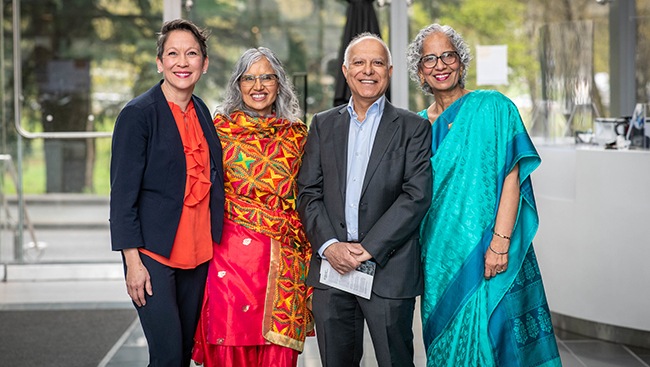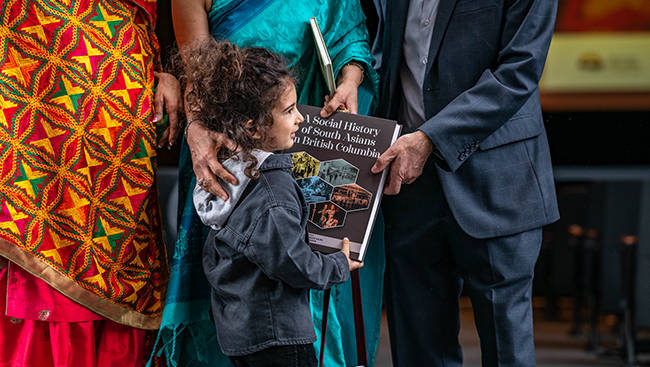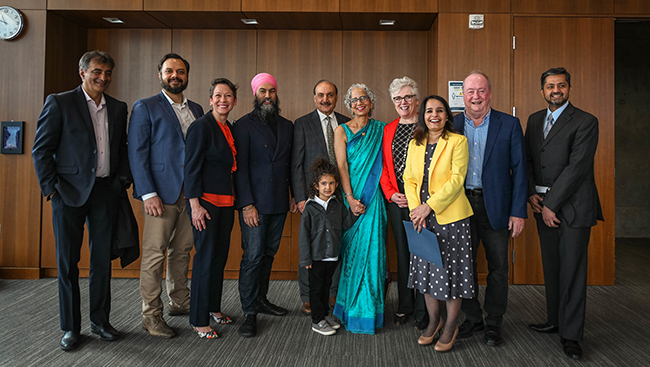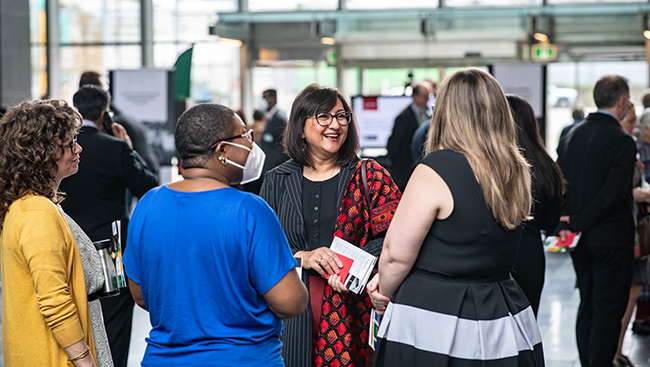Metro Vancouver is home to the largest population of South Asians in British Columbia (BC) and the second largest in the country. With notable contributions to the country’s economic, financial, governmental, social, and cultural fabric, South Asians have definitely garnered much recognition and appreciation. However, just as important as the celebration of present accomplishments and future potential, is the acknowledgement and preservation of history. Upholding such a privileged responsibility is the South Asian Canadian Legacy Project (SACLP), conceived as a provincial project in 2015 by Dr. Satwinder Kaur Bains, Director of the South Asian Studies Institute (SASI) at the University of the Fraser Valley and Dr. Tzu-I Chung, Curator of History, Royal BC Museum.

For five years, Dr. Bains and her team developed and implemented a plan to (re)cover the long and triumphant history, heritage, and culture of South Asians in BC by traveling to seven regions across BC. The travels acquainted the team in greater detail with the history of migration, settlement, and adaptation by South Asians from the early 1900s to contemporary times. The primary drivers behind the establishment of SACLP were community members themselves, who were thirsting for South Asian history to be explored, recorded, and shared as part of the Canadian record. The BC Government supported the vision to develop and deliver six projects that captured the needs of South Asian Canadian communities across the Province. Launched with provincial funding in 2020, SACLP includes these six initiatives aimed at building a more truthful account and robust library of resources intended to benefit generations of learners from all communities.
Traveling Museum Exhibit
A bilingual exhibit titled Haq and History, haq meaning “rights” in Punjabi, was developed in collaboration between UFV and the Royal BC Museum. It explores themes of trans-Pacific journeys, families and homes, community celebrations and commemorations, sawmill experiences, and community activism for rights and justice. On display at the Surrey Centre Library until late June, the exhibit will move around the province, partnering with local organizations and South Asian Canadian communities to add relevant local content to the display in order to expand the historic record. The long-term vision is that these local and core exhibit panels will serve as the basis for a future South Asian Canadian Museum.
Public Social History book
Distributed for the first time at the April 12, 2022 unveiling, this public history book presents diverse South Asian Canadian social histories from across BC. Focusing on historical and contemporary migration, identity, and politics, this publication includes a variety of contributors from the diverse South Asian Canadian diaspora in BC. This substantial historical collection includes a compilation of the South Asian Studies Institute’s research, archives, and collections, accessible via www.threadingourstories.ca.

K-12 Learning Resources
Saffron Threads is a suite of resources for K-12 teachers that include South Asian Canadian culture, history, and heritage learning resources for social studies classes in schools across BC. Developed in partnership with Open School BC, it features detailed activity plans and resources, incorporates connections to the provincial curriculum’s big ideas and curricular competencies, and explores social studies, math, language arts, food studies, and more. Outreach boxes with the history of Paldi (a former South Asian settlement and mill town near Duncan, BC) for teachers will be available, as part of educational resources, through the Royal BC Museum Learning Centre, via www.saffronthreads.ca.
Digital Archive
This project features a searchable digital online archive that allows users to engage with the rich history of the South Asian Canadian diaspora from the first recorded immigrants to the story of the Komagata Maru (1914), through to today. The South Asian Canadian Digital Archive is an initiative designed to recognize the past of South Asians in BC, strengthen the present, and build a better future by recording and sharing stories, images and records. Readers may browse images from Indian and Canadian newspapers, migration letters, personal collections, and more, via www.sacda.ca.
Labor History
In partnership with the BC Labor Heritage Centre, the comprehensive research and development of resources of South Asian Canadian Labor History creates a robust account through historical documentation and research on South Asian Canadians and their involvement in the labor movements in BC. The project has culminated in a book, Union Zindabad!, and an online exhibit and exhibit collection published as part of the South Asian Canadian Digital Archive. Information is also being ported into K-12 curriculum development and can be accessed via www.threadingoutstories.ca.
Tour Historic Sites
This initiative boasts an easily clickable map of provincially recognized historic places in BC, as identified through the South Asian Canadian Historic Places Recognition Project. Categories include buildings and building features, including cultural landscapes and geographic features, streetscapes, districts, and communities. Each location provides a photo, address, and link to an official website. The interactive map can be accessed via heritagebc.ca/cultural-maps/south-asian-canadian-map.
The timing of the unveiling of the six components of the legacy project in April 2022 was particularly important to the South Asian community that was especially impacted by limitations on gatherings due to COVID-19 restrictions, explains Dr. Bains, “Reduced opportunities to visit homes and families in India — an important tradition for the South Asian diaspora — and eliminating opportunities for cultural and religious gatherings here in Canada left many isolated and alone. Add an increase in hate crimes across North America, and many were feeling more ostracized than ever.”

It is mentionable, though, that despite opportunities for reconnection and celebration allowed by the information generated by the legacy project, not all of the history uncovered along the way was positive. Examples of hate and intolerance stirred memories of Dr. Bains’ own experience immigrating to Canada in the 1970s, and countless examples she’s heard about and witnessed over the years. Still, the passionate and dedicated community activist believes that all facets of history are important to share. Equally committed are the many volunteers that are involved in various facets of bringing the project to life.
In fact, youth volunteers have been involved from day one, be it as research assistants, recruiters, interviewers, and/or event planners. When volunteers worked on the archive or the student resources, they learned an abundance of information about South Asian history, heritage and culture. Their eyes opened to the past and new doors were opened for a future that would be informed by the history of South Asian immigrant ancestors and those that followed. For most, this was history they had not had the privilege to work with before their involvement with SACLP. It has been a profoundly moving experience for all who are connected with the project.
Volunteering in a leadership role, Dr. Balbir Gurm has been part of the working committee since its inception as the Punjabi Legacy Project, when she suggested that the organization undertake consultations around the province. Dr. Gurm has enjoyed hearing from the community around the province and their unique contributions. Additionally, as part of a group of dedicated volunteers, she has helped successfully advocate to secure the funding needed for the South Asian Canadian Legacy Project. Over the past two years, Dr. Gurm has thoroughly enjoyed the many volunteer hours of learning about different South Asian Canadian settler groups’ experiences, alongside contributing to the various projects.
Dr. Gurm further elaborates, “I believe histories need to be told by those who have experienced them. I am proud that we were able to involve several different South Asian groups and create products the entire community could be proud of and I believe we have delivered them. These are just the beginning steps to document our history, there is much more to be done. I really would like as many people as possible to be involved in the South Asian Canadian Museum that the government has recently announced.” Certainly, it is a genuine milestone to have received the promise of a South Asian Canadian Museum in BC – the first of its kind in the province and country. Needless to say, the SASI will be heavily involved in that work. Undoubtedly, this is the outcome of the organization’s commitment to recording South Asian history, sharing it with others, and being proactive caretakers of both our past and our future.
Despite the progress, however, the challenge remains in the recognition and acknowledgement that we are 50+ years behind in doing this work. Many of our elders have passed on and so has a full library with them. Access to that knowledge and information is not available first hand and the SASI is striving to record second and third hand accounts, which are still rich and robust, but are not the same as having access to the early immigrant settlers themselves. The two-year time frame to do the work and produce outcomes that are now the foundation of the work ahead has been a challenge, but the hardworking team at SASI are up for it and relay that they are looking forward to the next 25 years!
With such enthusiastic energies spearheading this noble initiative, the future is bright and optimistic. The work that SASI does benefits all Canadians and the team can proudly attest that the curriculum in our schools, history in our homes, historic sites in our communities, and archives in our libraries have come alive for everyone, both on paper and online. All resources are freely available online and the work ahead entails keeping people engaged with the work, encouraging them to take pride in the history and heritage, and motivating them to find the courage to come forward and tell their stories too, while feeling privileged that South Asian history is now part of the Canadian record and can be shared far and wide.
It is evidently a significant step in the right direction that school children will soon engage with learning resources that speak to their experiences, professors will create course work that includes SACLP resources, labor movements will benefit from the long and arduous history of activism as a record, people may visit historic sites and know the history behind them, exhibits will travel across the province and will be available for many to engage with, and so on. The list of positive impacts is truly endless. The team’s work is surely incredibly diverse and far reaching, for which both SASI and the larger community should be proud, while eagerly sharing it with all British Columbians.
As the project grows, SACLP’s Marketing and Communications Consultant, Jesse Kaufman shares that he is honored and proud to help amplify the important resources produced. “It is inspiring to work with the passionate and powerful leaders at SASI. The atmosphere working on this project is electric. We all understand the legacy of the work and it drives us to be creative in the project’s rollout so that it can have maximum impact in the community.”, highlights Kaufman. He urges all to share the project with friends and neighbors as it is a unique gateway to six resources that tell the tragedies and triumphs of the South Asian Canadian community in BC. After all, when we engage with resources that challenge us to learn about our shared history, we work towards a more inclusive society for all.

There is no question that the South Asian Canadian Legacy Project transcends the boundaries of BC in its relevance and impact. Stirring important community discussions in the public sphere, the South Asian Studies Institute is a catalyst for change nationwide, and even worldwide, for South Asians and beyond. The initiative and accomplishments of this project are exemplary and stand as testament to the power of history in shaping our present and future. As the community comes together to experience and add to the success of SACLP, South Asians’ valuable and precious historic footprints will indeed continue to be rightfully protected, preserved, and passed on for generations to come. The public can access all six of SACLP’s resources via www.threadingourstories.ca.
